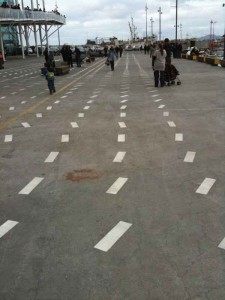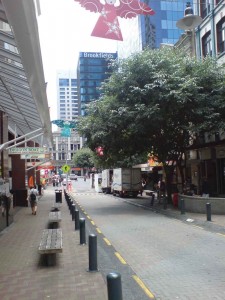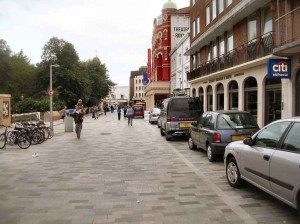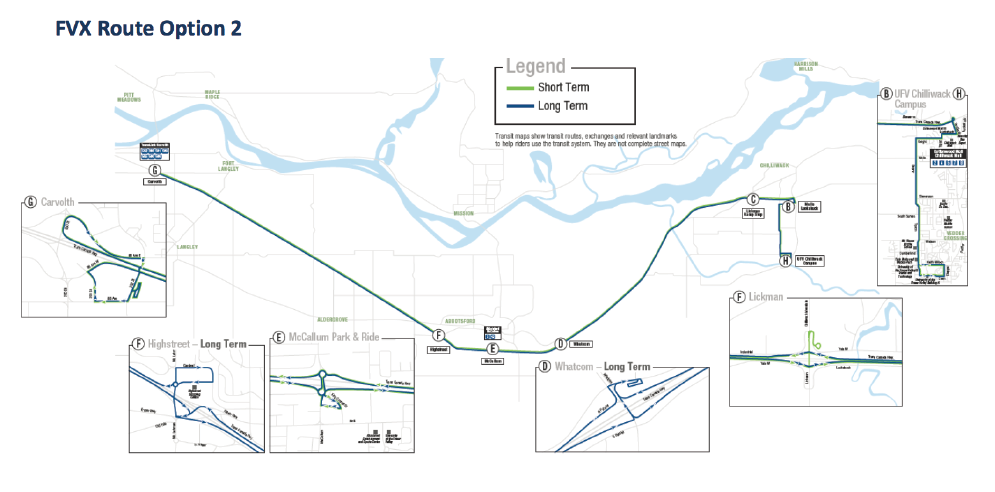By Megan Lambert and Michael Scoular (The Cascade) – Email
Print Edition: October 15, 2014
The past year has seen a number of changes in student transit options: the Student Union Society (SUS) initiated a Chilliwack-Abbotsford Campus connector shuttle, for which service was later expanded, and BC Transit has been on campus multiple times with surveys about proposed service changes. And more is coming.
Connector upgrade: part two
First, there’s the campus connector, which, according to SUS data, is in need of more service between Chilliwack’s Canada Education Park (CEP) campus and the UFV Abbotsford campus.
“The primary reason [for the referendum] is to address … people [that] have been left behind [each week],” VP internal Thomas Davies says. “We’re adding a bus through the period that we’re having all the turn-aways.”
SUS estimates 85 students a week are being left at stops due to rides running at-capacity. Davies suggests the margin of error means this number might be lower than the actual amount.

This time last year, after re-considering the cost of running a CEP-Abbotsford connector compared to ridership numbers, SUS proposed and passed an increase, from $6.75 to $17.75 per semester.
Now there are two questions that will be posed to students. Revising the CEP-Abbotsford shuttle schedule and increasing the number of shuttles running during the morning and afternoon would tack on another $3.50 to the fee.
SUS is also proposing a connector service that would reach students from the Langley area, which would begin downtown near the Langley Centre bus exchange and end at the Abbotsford campus, although the exact route is yet to be finalized. The fee for the creation of this route would be $5.45 per semester.
There is no UFV campus in the Langley area, but Davies argues that there is a bus service connecting Mission students to Abbotsford, where there are slightly fewer UFV students than there are from Langley. (The number of UFV students living in Mission has declined each year since 2009-10, when part of the business program was taught at the Heritage Park campus.)
Students will be able to vote either in favour for or against each service addition individually at the end of the month (from October 30 to November 4). If passed, service would begin for the winter semester.
Fraser Valley Express still in the works
If SUS’s plan sounds familiar, that’s for good reason. BC Transit has had a Langley-Abbotsford-Chilliwack bus connector in various stages of development for over a year. After a delay in approval from Abbotsford city council (Mayor Bruce Banman brought the issue up a second time after it was initially halted by a tied vote), the Fraser Valley Express was scheduled to debut in September 2014, and then re-scheduled for April 2015.
The FVX differs from the UFV connector in a number of ways. At an information open house, BC Transit allowed students and community residents to fill out a survey, with one option asking students to choose between stops in Chilliwack’s downtown or the CEP campus. The FVX would also have a different Langley destination, as it would leave from the Carvolth exchange, a location about 10 kilometres north of the Langley Centre.
There are still a number of details yet to be finalized. Fares were tentatively set at $6 for a one-way trip with no transfer to other BC Transit services. The FVX’s place within the pre-existing U-Pass program would also be a matter of negotiations between BC Transit and SUS, an unlikely situation if the connector referendum passes.
“In an ideal world, if the price is right and if students are fine with paying that price, we’d like to see some combination of programs,” Davies says. “As that program comes alive, and as we see how our demand is shaped for the Langley service, we’ll take a look and see how we can create efficiency for students just by merging programs together, or adjusting service times, or whatever it may be.”
City planner presents at UFV
For students who attended a transit presentation led by New Zealand city planner Darren Davis, these types of options and considerations were forefront. Organized by the UFV Urbanists group, Davis spoke of his experience with a town roughly the same size as Abbotsford (Hamilton, NZ), which also had, at the time he began work there, a similar public view of taking the bus — they mostly did not. Since then the number of people using public transit has steadily risen.

“[We] changed the conversation about public transport in Hamilton from one that was really marginal … to one that was actually useful for quite a number of different things,” he said.
There are a host of issues and questions that can be used to approach public transit: who rides it (low-income or non-working residents, students, seniors), who pays for it (New Zealand differs from Abbotsford in how it only has one level of government that handles transit), how it affects the community it runs through (environmentalists, business owners), and many other more intricate ways of fitting infrastructure and geography together. Davis said, for a start, that how transit is fundamentally operated makes an enormous difference.
This means looking at redundancies across different levels of transit (something relevant given the FVX/SUS services). “Just getting the existing network to work reliably,” Davis emphasized, can be enough. In Hamilton, this meant reducing wait times and making on-time performance a major focus. Davis suggested these adjustments mostly affect fuel purchase and driver hours, rather than the addition of actual buses, and therefore should not be beyond the budgetary limits of a well-functioning transit service.
Davis acknowledged the comparison between Hamilton and Abbotsford is not an exact parallel, though.
“We were in the fortunate position where the political context was broadly supportive of increasing public transport, [with] public and stakeholder acceptance,” he said. As well, some transit upgrades occurred in anticipation of the time of the 2011 Rugby World Cup, where some games were played at Hamilton’s Waikoto Stadium (which seats 25-35,000).
A lot of government spending in Hamilton also contributed to upgrades at the city’s central bus centre. Davis said government involvement is necessary, both to improve the public image of the bus service and to give easy, safe access to pedestrians using the transit lines.

“When you think about how you present public transport infrastructure to public transport customers, you see something about how you view those customers,” he said.
Closer to home, proposed re-alignment of Abbotsford-Mission bus routes was not implemented following a public survey earlier this year. Many residents expressed concern over the push toward using the Abbotsford downtown exchange instead of the one at Bourquin, which is located near the Sevenoaks Mall. The downtown exchange is poorly lit and consists of two shelters at opposite ends of a crosswalk. The Bourquin exchange has three shelters, a restroom for drivers, and is made out of a concrete island, though it lacks ample space for more than five running buses at a time.
As BC Transit’s summary stated, major transit additions or alterations “[would] require infrastructure investment to enable the service change proposals to be implemented. In addition, there were a considerable number of responses requesting an increase in service frequency and later trips on multiple routes. This desire would require additional service hours and operational budget.”
Davis repeatedly pointed out, however, that these kinds of changes could happen over a relatively short period of time (Hamilton’s have taken place over less than a decade).
One of the more noteworthy changes has been in New Zealand’s promotion of “shared spaces.” Designated streets are paved as walkways (setts or other pedestrian-friendly material), which emphasizes that those walking along or crossing the street have the right-of-way. “We’re not saying no to the car, but we’re saying the pedestrian has priority in the space,” is how Davis described it. Car-heavy traffic often re-directs itself to other routes as drivers adjust to the new layout. An obvious comparison would be Abbotsford’s downtown area, where there is already a lowered speed limit and a high level of visitors on foot to the area during periodic traffic closures for larger events.
Worries that this might discourage visitors to local businesses, Davis said, are unfounded. “It is the people on their feet who spend money,” he said, citing research their city has done before and after the change. One downside to shared spaces, however, has been that it does not provide enough differentiation in surface for disabled pedestrians, as the BBC has reported.
Especially given how the senior population is growing, Davis said making cities walkable and public transit accessible should be a priority for governments and citizens. (In New Zealand, many seniors qualify for free transit rides after 9 a.m. on weekdays and all weekends and holidays.) In Abbotsford, Davis said he saw evidence of new developments, but with gaps between them. Public transit and city planning will likely be a topic of note in the upcoming municipal election.
With files from Stewart Seymour.



